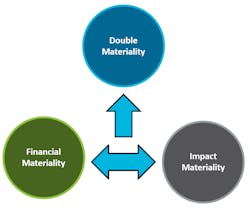Over the past few years, there has been growing demand from business stakeholders to integrate environmental, social and governance (ESG) principles into their broader corporate strategies, in part due to mounting evidence that ESG maturity helps companies improve their financial importance and avoid business volatility.
As ESG conversations have continued, more businesses have started to pivot from traditional EHS management to ESG management. Safety management, which is part of the “S” (for “Social”) in ESG, is an essential part of establishing and maintaining ESG maturity.
EHS professionals managing workplace safety initiatives have important roles to play in that shift. In fact, polls we’ve seen during conference presentations indicate that many companies are tasking their traditional ESG managers with management of ESG initiatives. Still, many EHS professionals lack easy access to practical guidance about how to develop ESG strategies that build upon their existing safety management strategies.
The concept of “materiality,” which we can think of as a kind of lens that company management and stakeholders use to determine their most important ESG issues, is an important tool to focus ESG priorities. In what follows, we’ll break down the concepts of “materiality” and “double materiality” and share some key takeaways about their importance to ESG management—and to EHS professionals helping their organizations navigate the journey to ESG maturity.
Safety is Essential to ESG
If you’ve attended EHS conferences during the last few years or read trade publications, you might’ve noticed many mentions of ESG. But you’ve probably also noticed that most of those presentations and articles have a narrow focus: they offer generalities about ESG management, or they are limited to discussions about greenhouse gases (GHGs), climate risks and maybe a few other environmental topics.
There is rarely any mention of the “S,” or “Social” aspect, of ESG, which includes the company’s relationships with customers and the broader community, but also includes—and builds upon—a foundation in occupational safety management. Safety management is a fundamental responsibility. At any given time, most of an EHS professional’s responsibilities includes safety tasks, such as investigating and documenting injuries and other accidents, performing inspections, tracking, following up on corrective actions, and managing a safety data sheet (SDS) library and hazardous chemical inventory.
Safety tasks can be especially burdensome because some safety regulations, such as OSHA’s HazCom Standard and Recordkeeping Standard in the U.S., apply to many workplaces. These are reasons why, while commitment to ESG initiatives might come down from the C-suite, traditional EHS and safety professionals like you will play an important role in day-to-day management.
This also means that EHS professionals may find themselves managing ESG initiatives. In order to be successful, you’ll need to get a handle on basic EHS tasks first before you can understand how safety management fits into your overall ESG management strategy. Think of your management approach as tiered, like the levels of a pyramid. You can’t build ESG maturity unless you first establish a solid foundation in ESG management, as shown in Figure 1.
Safety plays a major role in helping you navigate the journey from EHS to ESG. Building good stakeholder relationships with both company executives and non-managerial workers, such as maintenance department representatives and temporary workers, is key to advancing your ESG journey. Having a diverse group of stakeholders will help you identify areas for improvement, share responsibility for key tasks, and prepare to conduct a materiality assessment, which is central to improving your ESG management.
Of course, the “S” in ESG goes well beyond occupational safety and health and regulatory compliance. Taking your safety management to the next level can help you address concerns such as social sustainability, which refers to creating successful places where people live and work, both inside and outside the workplace. Internal aspects of social sustainability involve not only preventing injuries and illnesses but also protecting the general health and well-being of employees, including their mental health and psychological safety. Improving employee engagement on safety ensures they’re at the table for important decisions regarding their safety and reduces exposure to psychosocial risks as well as traditional safety risks.
One of the most important elements of social sustainability in the workplace is ergonomics, which is about designing the workplace to fit the worker. Similarly, physical demands analysis (PDA) is an important tool that enables employers to evaluate the physical demands of jobs. A post-offer employment testing (POET) based on the PDA can shield employees from the physical and psychological stresses of performing job duties beyond their physical abilities.
Materiality: A Key Step in ESG Management
Once you have effective EHS management practices in place and have identified key EHS and ESG stakeholders, the next step is to conduct a materiality assessment.
The easiest way to think of materiality is as a relevancy filter for the issues that matter most to an organization. That information is considered material, or relevant, if it could influence stakeholder decision-making regarding the company. The exercise of determining what issues are material to your organization is called a materiality assessment.
This might sound like a great place to begin your whole ESG strategy, but it doesn’t always play out that way. Many organizational leaders decide to pursue specific ESG goals, often based on a choice of ESG reporting frameworks. That might not be a bad choice if you already know you’re covered by one of those frameworks. However, it can also lead to several less-than-ideal situations, such as overreporting or ignoring the risks and opportunities that could make the biggest impact on your own company’s ESG performance.
In other words, if you don’t start with a materiality assessment, you’re letting other people who don’t know the specifics of your company determine what’s relevant for you. It makes more sense for companies to conduct an assessment that captures the specific risks and opportunities for their business and sets them up for success. As an EHS professional, you’ll have an important role to play in developing the assessment survey, participating in it, and helping stakeholders understand and act upon the results.
What is Double Materiality?
It sounds simple enough to say that materiality is about relevance until we start asking how to determine relevance; that is, about the context or framework we use to determine the relevant issues. In ESG circles, there are two main ways of thinking about this breakdown:
- Financial materiality is about economic value creation. It’s focused on the issues that internally impact a company’s financial performance and its ability to create economic value for investors and shareholders.
- Impact materiality focuses on the external impacts an organization’s activities have, including to the community and the environment. These include the organization’s contributions to air and water pollution as well as greenhouse gas (GHG) emissions that add to global climate risks.
These two types of materiality aren’t mutually exclusive because some issues address both aspects. For example, a company that has an uncontrolled release of a hazardous chemical would certainly create external impacts on the local community, potentially on organisms in water and soil, and might also be opening itself up to regulatory violations and associated penalties, or financial losses from civil suits. Furthermore, a company with a high intensity of GHG emissions may be contributing to climate risks, including severe weather events that can damage their facilities or disrupt supply chains.
The relevance and interconnectedness of both impact and financial materiality are the reasons for the growing importance of the concept of double materiality, which as shown in Figure 2 combines both perspectives.
Materiality and ESG Reporting
One potential confusion about the different ESG reporting frameworks is that some are based on financial materiality and others are based on the double materiality concept.
For example, the proposed U.S. Securities and Exchange Commission rule would require GHG emission disclosures from all public companies, based on a financial materiality perspective. Similarly, the first two draft standards published by the International Sustainability Standards Board (ISSB) are also based on financial materiality. However, the draft European Sustainability Reporting Standards, recently published by the European Financial Reporting Advisory Group (EFRAG), would create mandatory disclosure requirements for tens of thousands of European companies based on a double materiality framework.
That doesn’t mean the approaches to materiality across frameworks won’t converge over time; there are reasons to think it might happen. In fact, the Global Reporting Initiative (GRI) emphasizes the importance of double materiality. GRI works with both EFRAG and the International Sustainability Standards Board (ISSB). EFRAG has a longstanding advisory relationship with International Financial Reporting Standards (IFRS) Foundation, the parent organization of ISSB.
And in the U.S., we’re starting to see regulatory agencies use impact and double materiality perspectives, with one example being the U.S. Environmental Protection Agency’s new Environmental Justice initiative that seeks to lessen the impacts of environmental exposure on vulnerable and historically marginalized communities.
Still, you’ll need to ensure you have simple, flexible methods for creating a materiality assessment based on multiple versions of materiality. From there, you can put your results into the form of a materiality matrix, which plots issues as a function of importance and potential impact. Your most significant issues will be clustered in the top right quadrant, so that your stakeholders can easily see where the most attention is required. Of course, your stakeholders must understand the results of the materiality assessment because the whole point of the assessment is to prioritize your issues so you can start developing the right strategies based on those that are most important to your business.
For example, it’s possible that in your company, musculoskeletal disorders (MSDs) represent a large portion of all occupational injuries. A materiality assessment would help everyone get on the same page so you can start planning and budgeting for tools to reduce MSD risk through ergonomics improvements. One possible tool would be ergonomics management software that uses artificial intelligence (AI) to identify MSD risk in job tasks so you can adjust the workplace to reduce that risk.
The overarching advantage here is that as you get more efficient by improving your focus and stakeholder participation, it starts to self-perpetuate. Time saved improving safety in one area frees up time to improve it in others. And if your EHS and ESG software facilitates sharing results, your stakeholders will see progress being made on your top priorities. That may make them more likely to continue participating in your strategic initiatives.
You Don’t Have to do ESG Alone
Modern EHS and ESG software can provide the support and efficiency you need. Ergonomics and health software makes it easy to account for the individuality and diversity of your workplace, conduct valid PDAs and build effective internal social sustainability strategies. You can also easily assemble materiality and double materiality assessment surveys from dropdown menus of ESG topics, deploy them to stakeholders, and then summarize results in an easy-to-understand format so that you can start developing effective strategies.
ESG maturity requires agility, and you’ll have the best chance of staying agile if your tools are agile, too.
Phil Molé, MPH, is an EHS and sustainability expert at VelocityEHS, a provider of EHS & ESG software platforms.


